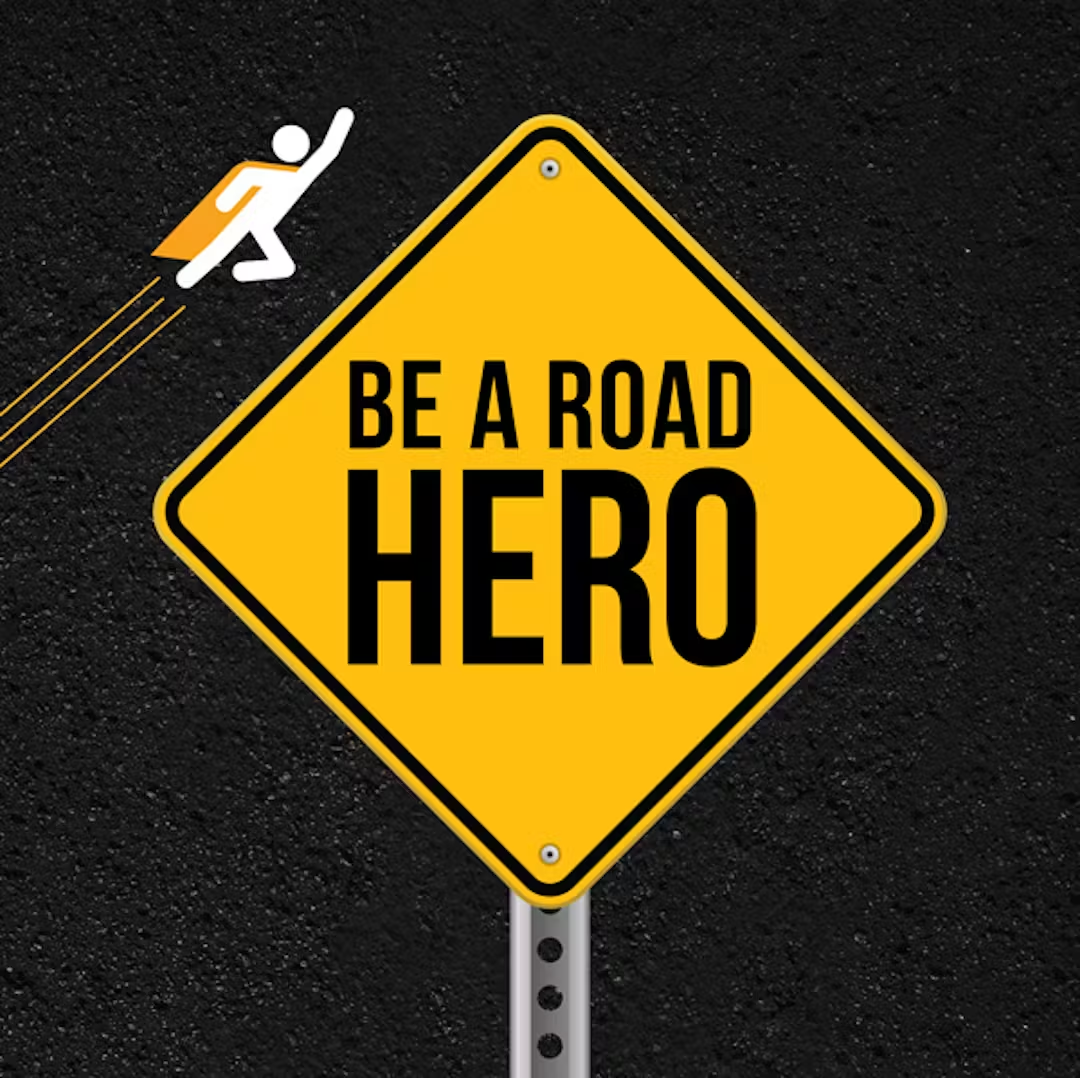Be a Road Hero: Traffic Safety Campaign

Use el botón de traducir en la parte superior derecha para españolAbout Be a Road Hero
The City of Kingston launched an initiative to improve traffic safety for motorists, cyclists, and pedestrians. “Be A Road Hero” is a public awareness campaign that educates residents on road safety.
What the City Is Addressing
Kingston dates back to 1652. Many of our roadways need updating to suit our current transportation needs. While the City is working to make modern improvements, traveler confusion, crashes, and dangerous near misses have affected the City’s roads. Then in 2021, three devastating cyclist deaths focused the need for an education campaign.
With the implementation of the Hurley Ave Complete Streets Project, the Broadway Streetscape Project, the Broadway Grand Intersection Improvement Project, the Pedestrian Safety Action Plan Project, the Empire State Trail, and the New York State Department of Transportation’s I-587 roundabout, there are many new traffic configurations to navigate.
Residents will find new traffic signs, reconfigured street lanes, a two-way cycle track, green bike turning boxes, traffic signals for the cyclist lanes, and synchronized traffic lights on Broadway. The recent improvement projects also include pedestrian-friendly amenities such as ADA-compliant sidewalks and curbs, and high-visibility crosswalks (with Rapid Flashing Beacons, RFB).
How the City Has Addressed It
The City issued a Request for Proposals and hired Niki Jones Agency to develop a Marketing Campaign, including branding and copywriting, and materials including 3 short-form videos, a direct mailer, and a social media campaign. The Be a Road Hero campaign results from a collaboration between City staff, a Project Advisory Committee, and consultants from the Niki Jones Agency.
The Outcome
Although more transportation communications may happen, here is the report created by the consultants about this project.
How To Be ‘Road Heroes’
The City of Kingston has launched a comprehensive education campaign, but Traffic safety is a two-way street. Stay informed on upcoming changes and always be alert, whether driving, biking, or walking.
What to know:
- Cyclists must obey all signs, street markings, and signals.
- Vehicles are never permitted to park in cycle tracks or buffer zone.
- Regardless of how you are traveling, stay alert, especially at crossings and cycle tracks.
Drivers! Be a Road Hero
The road is full of neighbors, friends, parents, and children…; Drive like they’re your own.
- Always watch for pedestrians and cyclists.
- Familiarize yourself with Kingston’s new street designs on Broadway and the I-587 roundabout.
- Check your mirrors and blind spot for cyclists, especially when traversing the cycle tracks to make right-hand turns or when opening car doors.
Cyclists! Be a Road Hero
Be predictable! Cyclists are safer when they follow traffic laws.
- Use the new cycle tracks and obey all traffic signals.
- Look for vehicles turning right and crossing cycle tracks. Even if your traffic signal is green, watch for motorists.
- Ride with traffic.
- Always watch out for pedestrians.
Pedestrians! Be a Road Hero
The City of Kingston has made upgrades to pedestrian signs, markings, and signals but pedestrians should still always watch for vehicles.
- Stay safe by using the new high-visibility crosswalks, ADA-compliant sidewalks, and updated crossing signals.
- Be visible. Never assume a motorist sees you.
Kingston Needs Heroes
Road heroes take action in times of change. Luckily, the behaviors needed for safer streets in our community begin with small, common-sense acts. Obey the laws, be alert, and keep an eye out for each other. No superpowers required!
How to Use the Broadway and Greenkill Avenue 2-way Cycle Tracks and Two-Stage Turn Boxes
The City of Kingston now has two-way cycle tracks on Broadway from the I-587 Roundabout to Grand Street and on Greenkill Avenue from the 5-way intersection to near Iwo Jima Lane. Below are some tips for using this infrastructure.
 What’s a cycle track?
What’s a cycle track?
A cycle track is a specific type of bike lane. Our cycle track on Broadway is two-way and protected by parked cars and a buffer zone. On Hurley Avenue, bike lanes were installed on both sides of the roadway and cyclists travel in the same direction as the adjacent traffic. On Greenkill, a 2- way bike lane separated by plantings creates a buffer from vehicle traffic.
How do I use the 2-way cycle tracks on Broadway and Greenkill Avenue?
A cycle track is a road, just like the other lanes on Broadway. Ride on your right when traveling, just like you would on any road. Be cautious at the green conflict stripes, this means there is a driveway or intersection where vehicles may be turning. Be cautious around parked vehicles, if they open a door suddenly you could crash. On Broadway, use the two-stage green turn boxes to exit the cycle tracks. See more about the green boxes below.
 What are those green boxes?
What are those green boxes?
Have you noticed the two-stage turning boxes at four intersections on Broadway? These allow cyclists to make turns from the cycle track. We call them two-stage because it may take two maneuvers to cross traffic.
Step one:
Ride along the cycle track until you get to an intersection with a green box. Stop before the white line and look for the bicycle traffic signal. Stop when the bicycle signal is red.
Step two:
When the bike signal turns green, roll into the green box and turn your bicycle the way you want to turn. Look across the street to the traffic signal. Do not cross until it turns green. (Note, users will not see a bike symbol in this signal, only when riding along the length of Broadway)
Step three:
When the signal turns green, look both ways and cross with traffic as if you were in a car. Watch for cars turning right and left. Proceed on your way across the intersection to the crossroad.
 How do I get in or out of the 2-way cycle track at the I-587 Roundabout?
How do I get in or out of the 2-way cycle track at the I-587 Roundabout?
If you are coming from the Roundabout or East St. James Street, if possible, make a left signal, and when it’s safe, cross traffic into the 2-way cycle track, cross E. St. James and merge onto the bike lane.
Exiting the cycle track at the I-587 Roundabout? Slow down and dismount your bicycle. Walk your bike on the paths that lead you through the traffic circle intersection to your intended exit. Stop and be cautious when the path crosses oncoming traffic. Try to make eye contact or get confirmation that drivers see you before you cross.
Bicycle riders also have the right to use the Roundabout as any motor vehicle does. Cyclists may “take the lane,” so look behind you, and when there is a break in traffic, merge into the lane and eventually into the center of the lane so that cars know they shouldn’t pass you. When you come to the yield line, stop or yield to traffic, before you enter the circle. Travel around the circle and exit at your intended turn. After you exit the Roundabout, when possible, move to the right to let faster vehicles pass.
How do I enter the bike lane at Prince St./Grant St and Pine Grove?
If you are cycling west on Broadway, when the traffic signal is green, continue into the bike lane on your right.
If you are coming from Pine Grove, or the YMCA, wait at the signal in the left lane. When it turns green, roll forward, yield to oncoming traffic, then make a left turn into the bike lane.
From Grand Street, enter the realigned intersection bike lane and if the signalis red, wait for the signal. When it turns green, enter the bike lane on your right.
I’m at Prince St. and Pine Grove Ave., now what?
If you are traveling east on the bicycle track and arrive at Broadway/Prince/Pine Grove, you have three options.
If you want to take a left onto Prince St. or Grand St., stop at the white line. When the signal turns green, watch for turning traffic behind you on the right, then make the left onto Prince St.
Going straight (east) on Broadway? Use the green two-stage turn box. When the light turns green, roll into the green box and turn your bike facing toward Rite Aid. Stop at the red light. If possible, use a left-hand signal to let traffic behind and in front of you know your intentions. When the light turns green, yield to oncoming traffic then make the left to continue along Broadway.
Heading to the YMCA or Pine Grove? Use the green two-stage turn box. When the light turns green, roll into the green box and turn your bike to face Pine Grove and the YMCA. Stop at the red light. When the light turns green, wait for oncoming traffic to pass, then continue straight.
Motor Vehicle Drivers
Never park in the cycle track or in the buffer zone! This is extremely dangerous for cyclists. If you block the cycle track, you may force a bicycle rider to swerve into traffic or collide with a parked car. Please park with your vehicle inside the striped parking spot and not in the buffer zone (the white striped area between the parking spot and the cycle track). If you park in the buffer zone and open your car door, you could seriously Injure cyclists. That is called being “doored” and can kill a bicycle rider. Try using the Dutch Reach! See below.
 The Dutch Reach
The Dutch Reach
Drivers, when you go to open your door, try the Dutch Reach so that cyclists don’t get “doored!” Rather than using your hand closest to the door to open it, use your far hand, this causes you to swivel and look back, to see if a bicycle rider is coming. Then open the door slowly. This small maneuver can save a cyclist's life. The impact and fall from hitting a car door can cause very serious injury.
What are the bicycle signals for taking a right and left turn?
 State law doesn't require a cyclist to signal if taking their hands off the bars would put them at risk. But it is a good way to communicate your intentions and may keep you safer.
State law doesn't require a cyclist to signal if taking their hands off the bars would put them at risk. But it is a good way to communicate your intentions and may keep you safer.
Turning Right
Fully extend your right arm in a straight line OR bend your left hand at a 90-degree angle up with your hand open.
Turn Left
Fully extend your left hand in a straight line.
Stopping
Bend your left hand in a 90 angle down with the palm open.
Consider taking the Smart Cycling classes with the YMCA of Kingston and Ulster. The curriculum comes from the League of American Bicyclists.






